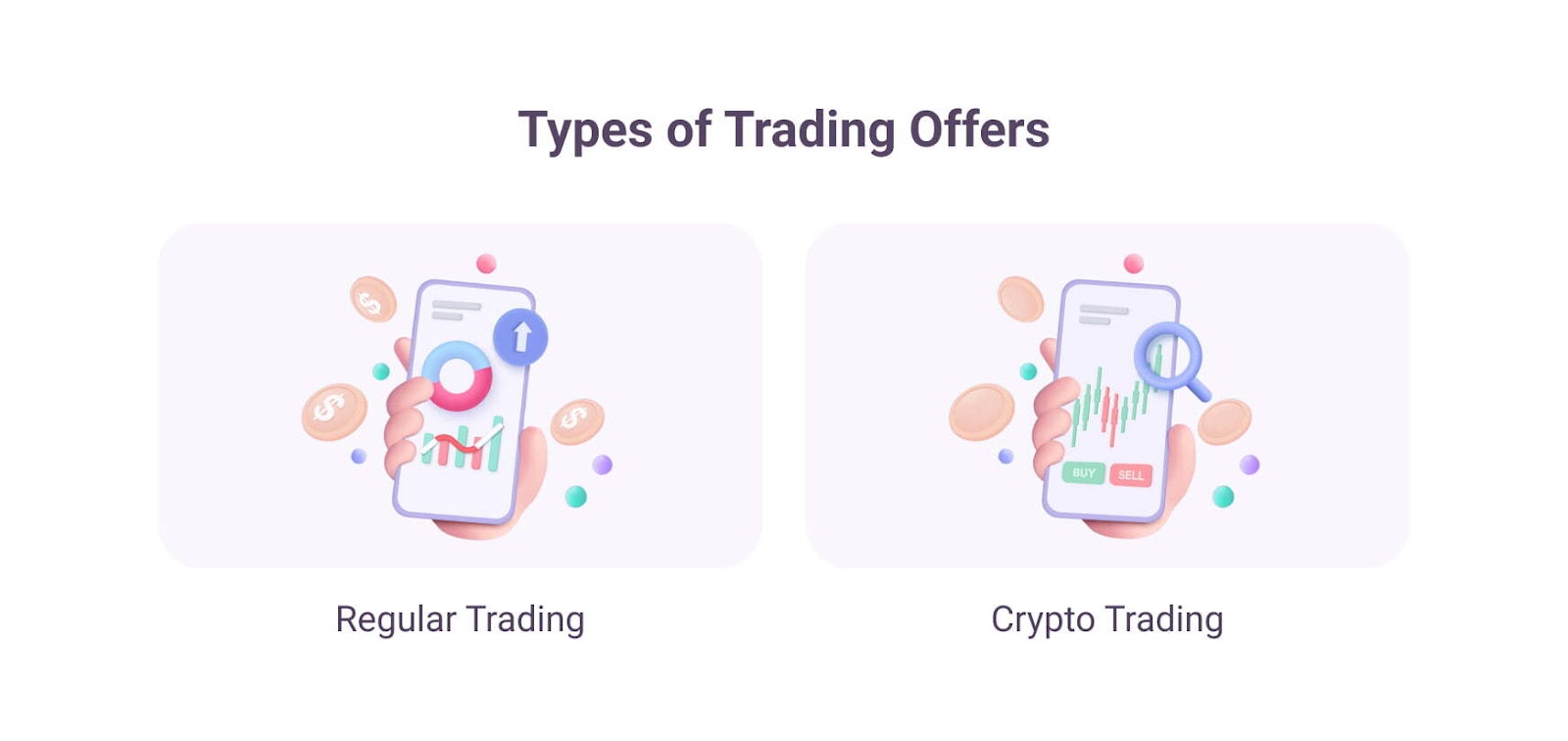Trading Vertical
The trading vertical is one of the most lucrative and dynamic in affiliate marketing. With more people looking to invest online, more users are seeking platforms to invest in forex, stocks, commodities and cryptocurrencies. This demand creates opportunities for affiliates to connect trading platforms with high-intent users.
However, trading offers are competitive and require a strategic approach to targeting, campaign optimisation and compliance. Understanding the trading meaning in affiliate marketing is crucial, as affiliates must grasp different monetization models and the nuances of financial advertising to succeed in this vertical.

What is the Trading Vertical?
Definition of the trading vertical in affiliate marketing is promoting financial services, brokerage platforms and trading tools to an online audience. These offers typically involve online trading platforms where users can trade financial assets such as stocks, forex, commodities, indices, cryptocurrencies and Contracts for Difference (CFDs).
Because trading customers are high-value, this is one of the most profitable yet competitive verticals in affiliate marketing. Affiliates partner with financial brands to drive new users to trading platforms and earn commissions through different monetization models.
How Does the Trading Vertical in Affiliate Marketing?
Affiliates promoting trading offers drive traffic to online trading platforms using various marketing strategies. These platforms provide users with tools and services to trade financial instruments, and affiliates earn commissions based on user engagement.
Types of Trading Offers
Trading offers in affiliate marketing are generally categorized into two main types.

Regular Trading (Forex, Stocks, Commodities, Indices, CFDs)
This category includes traditional financial instruments traded on regulated markets. These offers are for users looking for professional trading platforms and investment opportunities.
Key financial instruments:
- Forex (Foreign Exchange) – Trading currency pairs in the world’s largest financial market.
- Stocks – Investing in shares of publicly traded companies.
- Commodities – Trading physical assets like gold, silver, and oil.
- Indices – Speculating on the performance of stock market indices.
- CFDs (Contracts for Difference) – Trading on asset price movements without owning the underlying asset.
Crypto Trading (Bitcoin, Altcoins, NFTs, DeFi, Exchanges)
Crypto has taken off with the rise of digital assets. Crypto trading platforms offer spot trading, futures trading, staking and DeFi services.
Key elements of crypto trading:
- Bitcoin & Altcoins Trading – Buying and selling cryptocurrencies like Bitcoin and Ethereum.
- Futures & Leverage Trading – High-risk, high-reward strategies for experienced traders.
- NFTs & DeFi – Decentralized finance and digital collectibles.
- Crypto Exchanges – Platforms facilitating crypto transactions.
Monetization Models in Trading Affiliate Marketing
Affiliates promoting trading platforms earn through different commission structures:
- CPA (Cost Per Acquisition): A fixed payout when a user registers and deposits funds.
- Revenue Share: A percentage of the trader’s lifetime earnings.
- Hybrid Model: A mix of CPA and Revenue Share, ensuring both immediate and long-term earnings.
Economic Insights on the Trading Vertical
The online trading platform market has grown exponentially in recent years. In 2024, it was worth $10.86 billion and will be $17.46 billion by 2033, with a 5.39% compound annual growth rate (CAGR) during the forecast period.
The crypto market is booming. In 2024, it was $2,492.7 billion. It will grow at a 9.7% compound annual growth rate (CAGR) from 2025 to 2033 and will be $6,293.2 billion by 2033.
This is due to increasing internet penetration, technological advancements and more retail investors entering the market. Mobile trading apps and cloud-based platforms have also contributed to the growth, giving users more flexibility and accessibility. As the market moves forward, affiliate marketers need to stay on top of these trends to trading offers promotions and grab the opportunities.
Traffic Sources for Running Trading Ad Campaigns
Selecting the right traffic source is key to the success of trading affiliate campaigns. Each source has its own advantages and challenges, so choosing the most suitable one depends on your target audience, budget, and overall strategy.
- PPC Advertising – A great option for precise targeting, as it allows affiliates to bid on high-intent keywords. It delivers high-quality traffic but comes with high competition, strict ad policies, and significant costs.
- Social Media Ads – Effective for reaching a broad audience, particularly younger traders interested in cryptocurrencies. However, financial ads often face platform restrictions and require compliance with strict advertising guidelines.
- SEO Promotion – A long-term strategy that can generate cost-effective organic traffic, especially for finance-related content and educational blogs. The downside is that it requires substantial time and effort before seeing results.
- Push Advertising – One of the most effective traffic sources for trading campaigns due to its affordability, high engagement rates, and fewer restrictions compared to social media or search ads. It works well across multiple geos and audience segments.
- Pop Advertising – A budget-friendly method that delivers large traffic volumes with no restrictions. It is particularly effective for engaging broader audiences, including those interested in forex and crypto trading.
To make the decision-making process easier, we’ve prepared a comparison of these traffic sources, highlighting the pros and cons. 🚀
Best Traffic Sources for Trading Campaigns: Pros and Cons
| Traffic Source | Pros | Cons |
| PPC Advertising | – Highly targeted based on search intent– High-quality traffic with strong conversion potential | – Strict policies for finance offers – High competition increases costs– Requires constant monitoring and optimization |
| Social Media Ads | – Advanced demographic targeting (age, interests, behaviors) | – Ad disapprovals due to strict platform policies for trading – High costs |
| SEO Promotion | – Cost-effective for long-term traffic – Builds credibility and brand presence | – Time-intensive to see results – High competition in the trading niches – Requires ongoing content creation and backlink efforts |
| Push Ads | – High engagement rates with attention-grabbing notifications – Cost-effectiveness – Ease of launch – No restrictions on trading offers – Advanced targeting options – Works on both mobile and desktop | – Continuous optimization is necessary for best results |
| Pop Ads | – Affordable, high-volume traffic – No restrictions on trading offers – Creative independence compared to push or social media ads | – Needs strict budget control and frequent optimization (1-2 impressions per day per user) |
Why Choose ROIads for Trading Traffic?
Running trading campaigns on ROIads ad network is a smart choice for affiliates looking for high-quality push and pop traffic. With competitive pricing, no restrictions, and advanced targeting options, you can efficiently scale your campaigns and maximize profits. Our platform ensures a seamless experience with precise traffic segmentation, Micro bidding and AI bidding technology, helping you get the best results from every dollar spent.
Why Promote Trading Offers?
The trading vertical remains one of the most profitable affiliate niches due to:
- High Payouts: CPA commissions range from $100 to $1,000 per lead.
- Recurring Revenue: Long term earnings through RevShare model.
- Growing Audience: Rise of retail investing and crypto trading expands the customer base.
Conclusion
The trading vertical in affiliate marketing is a high-reward niche that requires expertise, compliance, and strategic targeting. With lucrative CPA and RevShare models, affiliates can earn substantial commissions by driving high-quality leads to trading platforms. However, success in this space demands deep knowledge of financial markets, audience behavior, and the best-performing geos for maximum ROI.









